In Pollution: Part One – The Plight of Plastics. I wrote about the dangers of plastic to our environment. There is a risk of animals eating it or getting caught in it and dying. Chemicals can leach from it, polluting the water. It can physically choke out areas where plants and animals could live.
In this post, Part Two, I’m considering the lifespan of plastic pollution and how it travels.
Plastic has a long lifespan. Plastic can take hundreds, even thousands of years to decompose. This is because there are very strong carbon to carbon bonds in plastics. These bonds are so strong that they do not break down in the same way that other materials with weaker bonds break down. For example, paper has a weaker bond and decomposes more easily. It actually takes too much energy to break for microbes to degrade plastic; plastic doesn’t usually biodegrade, or get broken down by microorganisms.
In fact, plastic only efficiently decomposes in the presence of light – a process called photodegradation. Photodegradation happens when UV from sunlight breaks the bonds of a compound. For plastic this basically means that light breaks big pieces of plastic into smaller pieces of plastic. If plastic ends up in the deep ocean or in a shady forest where little light penetrates, it isn’t likely to break down very quickly or at all. In the shallow parts of the oceans where light is able to penetrate the water, plastics can break down in as little as a single year. The problem with this is that while breaking down, dangerous chemicals such as bisphenol A (BPA) are produced and released into the water. These chemicals get consumed by marine life which then gets consumed by humans or they wash up on shore where they then come in direct contact with humans.
Plastic is very durable.
One piece of plastic, tossed into the ocean, can travel around the globe time and time again. Plastic will survive through currents, the digestive systems of animals and will withstand the effects of microbes. Wow.
My colleagues here at WonderLab, frequently discuss pollution and plastics. These days, it seems like anyone who travels, has a story about plastics and pollution. Here are three stories that we were discussing recently:
Story 1: Plastic Pollution Close to Home
“My family and I went hiking at Grubb Ridge which is in a national park about 6-10 miles south of Lake Monroe in Southern Indiana, U.S.
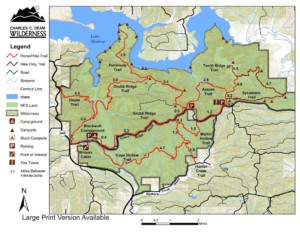
This is a map of the Charles Deam Wilderness in Indiana US. Grubb Ridge is a trail within the wilderness preserve.
This is considerably far from people yet we found three deflated helium balloons a few miles into the forest. They were stuck in a bush on some thorns. They had obviously floated there from town. Two were new and obviously from a St Patrick’s Day celebration (which had just passed the previous weekend). The other, a happy birthday balloon, was badly shredded and had clearly been there for a while.
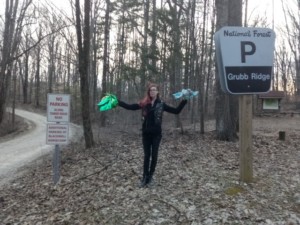
Sam Couch holds the helium balloons she recovered from thorn bushes off trail in the Charles Deam Wilderness. Photo taken by Joseph Elkins.
We maneuvered our way into the brush to remove the balloons and hiked them back to base for disposal.” – Sam Couch, Animal Exhibits Manager, WonderLab Museum
Story 2: Plastic Pollution In Iceland
I was once in a very remote part of Iceland called the “hornstrandir“.
Most of the Hornstrandir is a national park. Only a handful of people live there. There are no roads in or out – you have to get their via boat. We backpacked for several days in the wilderness, using compass and maps to find our way. We eventually made it to the ocean and were greeted by a surprise sight: tons and tons of washed up fishing waste! There were nets, styrofoam floats, plastic tubing, and large metal buoys along with lots and lots of natural driftwood.
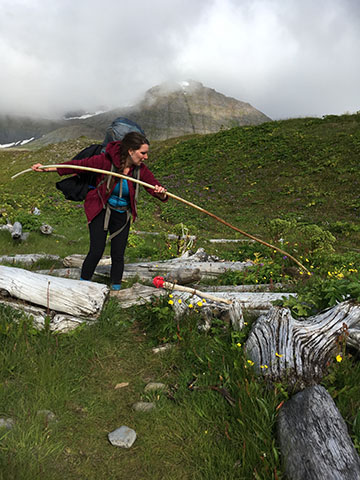
Emmy Brockman collecting trash from the shoreline of hornstrandir in Iceland. Photo courtesy of Emmy Brockman.
We found out later that the ocean currents are such that their is always junk on those beaches and it can be a real problem for the arctic foxes, puffins, and other sea birds that live there. I ended up finding something useful to do with the washed up trash – I had forgotten hiking poles so I fashioned some using hardened plastic tubing, and a section of net I cut.- Emmy Brockman, Education Director, WonderLab Museum.
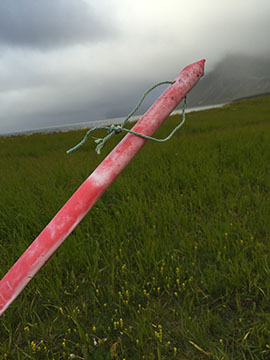
This is the hiking stick Emmy fashioned out of the trash she collected from the hornstrandir in Iceland. Photo by Emmy Brockman.
Story 3: Plastic Pollution in Bali
Living on a small island off the coast of Bali, there was no easy or fast way to get rid of trash. With this, seeing trash where it didn’t belong was a common occurrence. Those living on the island do their best to clean up, both underwater and on land, through weekly cleanups and other local conservation project.

Clean-up efforts are made by locals, island residents and tourists, everyone helps out! Multiple trash bags full of debris were filled in less than an hour while walking down the beach. Most dive shops hosted beach cleans-up once a week. With over 10 dives shops on the island there was some type of clean-up almost every day. Photo by Elly Perez.
The problem? A growing tourism industry and overall island population coupled with a waste management infrastructure not apt to handle the mass amount of trash being produced, it simply becomes too much. – Elly Perez, Animal Exhibits Intern, WonderLab Museum.
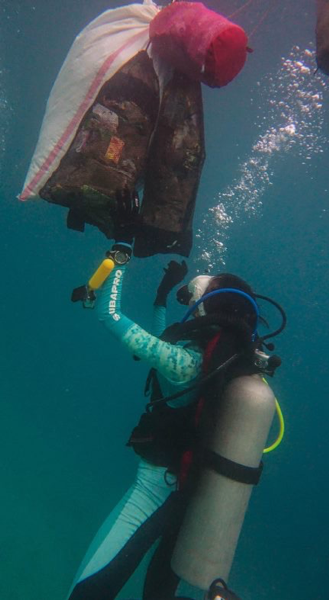
You can see multiple bags full of trash found along just one reef in Indonesia being brought to the surface. Photo by Elly Perez.
So, how does this even happen?
How does trash from one part of the world find its way to other parts? This happens largely in part by ocean currents. The term “ocean current” refers to the natural movement of water through the ocean and they are generated by three main factors:
- Wind helps generate surface currents which are the waves you feel at the beach.
- The rise and fall of tides: Tides refer to the level of the shoreline. Sometimes the shore is really high, meaning the tides are in,and sometimes it is far out, meaning the tides are out. This change in sea level is caused by the gravitational pull the moon has on the waters of the Earth as it rotates around us.
- Thermohaline circulation, or the movement of water caused by differences in the current’s salinity and temperature. As sea water freezes at the poles, the water is trapped as ice but the salt is left behind. This saltier water is dense and sinks. Warmer water is then pulled from the equatorial region to the poles, eventually freezes, and new water sinks.
The natural movement of water, or currents, is very important for the transporting of nutrients and organisms throughout the ocean. These currents are also very good at transporting the trash created by people that has found its way to the ocean. Once caught in these currents, trash can be taken anywhere around the world because we have made plastic so strong!
These three stories happened in three completely different areas of the world by three different people connected only by their place of work. Wow.
It’s easy to forget that we humans are each only on the planet for a short time; our trash will last on this planet much, much longer. A candy bar might taste really great now, but when I finish eating it the wrapper will be around long after I am dead!
Check back for more information on how YOU can help limit your contribution to the Plight of Pollution!
Resources and References
- American Chemistry Council
- National Oceanic and Atmospheric Administration
- National Ocean Service: Thermohaline Circulation
- Science Daily:Biodegration
- Why Doesn’t Plastic Biodegrade?



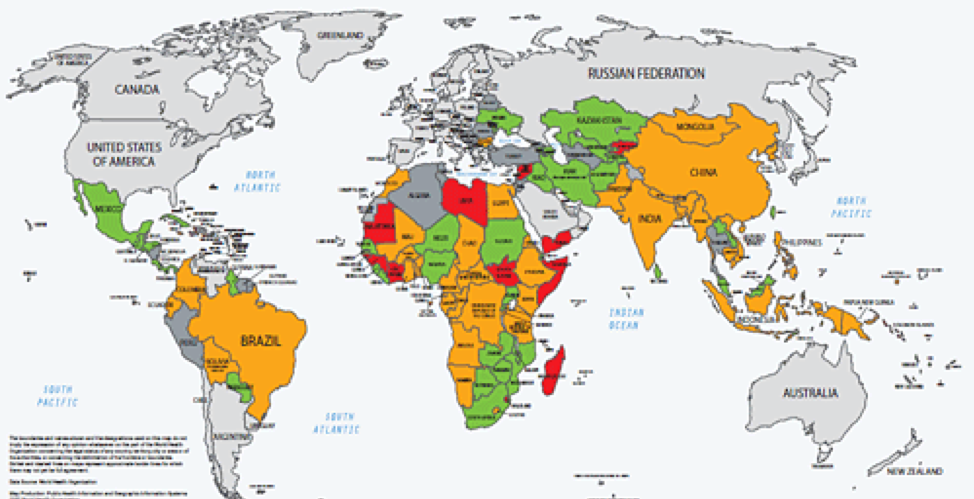
Leave A Comment